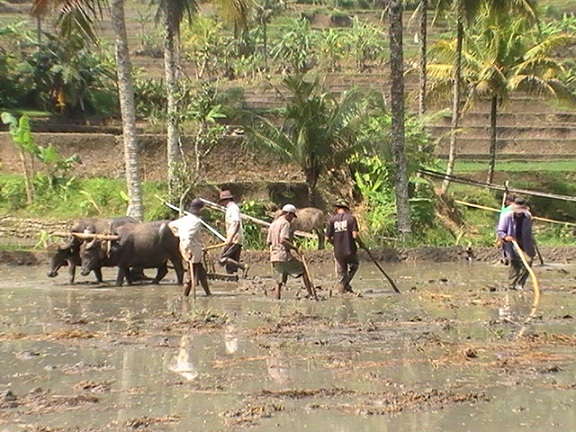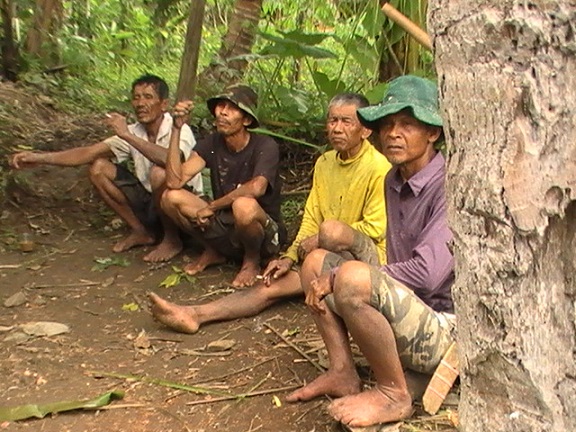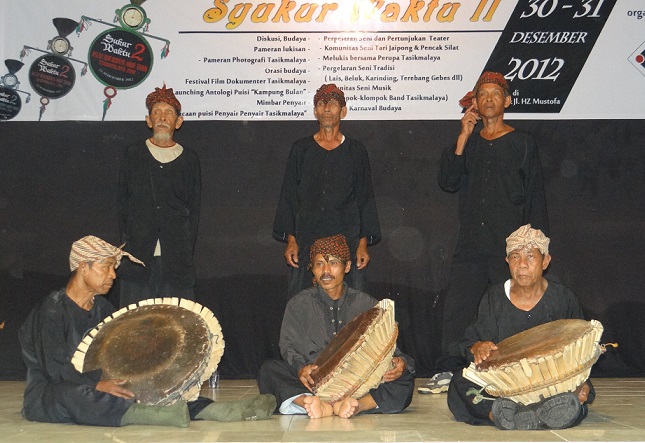A nearly extinct rural Sundanese art form is being revived in an urban setting
Neneng Lahpan
Performing beluk as part of 2013 New Year celebrations in Tasikmalaya Iip Yahya
The rain failed to dampen the spirits of the local artists taking part in the New Year celebration. They were forced inside, abandoning the outdoor stage, but their performances went on, a culmination of the seminars, exhibitions and street parade that had enlivened the two-day festival in the West Javanese city of Tasikmalaya.
Most of the performers were young, and their performances were contemporary in style. But after the night time Isya prayers were said, a group of older performers, dressed simply in black shirts and headbands, took to the stage and began singing to the accompaniment of three percussion instruments. There were no lyrics as such, just an exchange of high-pitched voices. The performers came from the village of Cikeusal outside Tasikmalaya, and they were demonstrating an ancient form of beluk, a traditional vocal art that once used to be heard all over the Sundanese hinterlands of West Java.
In the distant past, this type of beluk was sung in the fields as an accompaniment to the rhythms of rice cultivation. Now, however, it is almost extinct. Performed as part of the Tasikmalaya festival for a young audience seated on chairs in a public meeting hall, it was a symbolic enactment of Sundanese identity, an expression of the new political meaning being attached to traditional cultural forms in contemporary West Java.
From field to stage
Originally, beluk functioned as a form of communication between farmers working in isolated patches of dry rice fields in the mountains and valleys of the Sundanese homelands. According to oral tradition, the high-pitched tones of beluk derived from the need to be heard over long distances, as farmers advised one another of their presence in distant fields. When darkness fell, beluk singing was a way of helping farmers to link up with others who were also making their way home for the night.
When dry land rice farming gave way to the cultivation of rice in sawah (irrigated fields), beluk singing came to have another function. At this time, the performing arts in the villages were all associated with the cycle of rice cultivation. Beluk belonged to the ploughing stage, as farmers and their buffaloes prepared the fields for planting the young rice plants. Another type of performance, the dance form called rengkong, evolved out of the work associated with the harvest and mimics the graceful, rhythmic movements of those who carried the harvested rice on poles to the traditional storage barns. The work of the women who pounded the rice in preparation for cooking produced the musical form known as tutunggulan, while relaxation after the children’s bedtime was the origin of the percussive art form called terebangan. These various art forms were seen as ways of enhancing the efficacy of the activity they were associated with. Singing beluk came to be intimately involved with the care traditionally given to buffaloes. When a buffalo was being born, beluk would be sung as a way of ensuring the safety of the animal giving birth. During the planting season, it was believed that the singing of beluk would strengthen the buffalo and increase its working spirit.
 A very rare ‘performance’: ploughing a field to the accompaniment of beluk singing in Cikeusal in early 2013 Komunitas Cermin
A very rare ‘performance’: ploughing a field to the accompaniment of beluk singing in Cikeusal in early 2013 Komunitas Cermin
During the New Order period, as rice farming became more intensive and machines and cows started replacing the work of buffaloes, beluk gradually moved indoors and changed its character. It became a singing style for reciting wawacan, texts in Sundanese telling the stories of Islamic heroes, and it was performed as an accompaniment to life cycle events such as marriage, circumcision and akikah (the celebration that occurs seven days after the birth of a baby). The earlier form, which came to be known as ‘beluk sawah’, began to die out, and as purer forms of Islam became established in the villages, the newer version of beluk was itself replaced by Arabic-influenced forms of Islamic chanting, such as solawatan, barzanji and marhabaan. Today, recorded pop music is a regular part of life in the village, and when live music is performed for social events and entertainment, it is also likely to be a form of pop, either ‘dangdut’ or ‘organ tunggal’, a new performance style featuring a solo singer with electronic keyboard accompaniment.
Beluk sawah has thus become a reminder of pre-Islamic Sundanese culture, a link to an authentic past but not part of contemporary life. Now, when beluk is heard in the fields, it is a special event. In Cikeusal, people gather to enjoy the singing, watching the famers ploughing the fields with their buffaloes in the morning sunlight. Owners of the fields even pay more to farmers who can accompany their work with beluk. Here, in the village setting, beluk is something shared by performers and audience, a celebration of what they have in common, their social ties as wet rice farmers. Perhaps too it is a reminder of what they have lost. It is no accident that, these days village audiences for beluk are mainly made up of older people.
New audience, new function
When the beluk singers from Cikeusal perform in the city, their audience consists largely of young people. For them, the sound of beluk is a link to the lost world of their ancestors, and a nostalgic reminder of the authenticity of village life. It represents a part of their identity that is locally generated, rather than coming from the wider Indonesian and international worlds. Its promotion is part of a deliberate fostering of ‘Sundaneseness’ through language and culture that has been actively pursued by the regional government of West Java and certain key individuals since the enactment of regional autonomy laws in the early years of the twenty-first century.
 Beluk singers as farmers Komunitas Cermin
Beluk singers as farmers Komunitas Cermin
One expression of this celebration of Sundanese identity has been the emergence of Komunitas Cermin, a community of young artists in Tasikmalaya dedicated to reviving old performance traditions and making them known to a young audience. For them, beluk is an authentic expression of Sundanese identity in its purest form. They have sought out opportunities to involve the beluk singers from Cikeusal in staged urban performances, not only in regional cities like Tasikmalaya, but also in the provincial capital, Bandung. In contrast to the New Order period, when local traditions were monitored and kept alive through oversight and funding from the national government’s Department of Education and Culture, groups like Komunitas Cermin are local initiatives, responding to regional government calls for the enhancement and promotion of regional cultural identity.
The Cikeusal beluk singers themselves are proud of their new role as performers of this ancient form of Sundanese culture for an urban audience. They have appeared on radio and TV programs, and their singing has even been recorded. However, as opportunities for performance are limited to special events like festivals and citywide celebrations, their lives have not been transformed by their new role as custodians and transmitters of this aspect of the Sundanese heritage to young people. They are still farmers who go to work each day in their fields. It is their audience that has changed, along with the function of their art form.
No longer an integral part of village life, beluk has become a staged performance that re-enacts an aspect of the ancestral heritage of the Sundanese people. While young people in rural areas turn to globally influenced musical styles for entertainment and relaxation, the revival of beluk in urban settings brings the past into the present, contributing to the construction of an ‘authentic’ Sundanese identity for young city dwellers in contemporary West Java.
Neneng YK Lahpan (neneng.lahpan@monash.edu) is a PhD candidate in Anthropology at Monash University.



